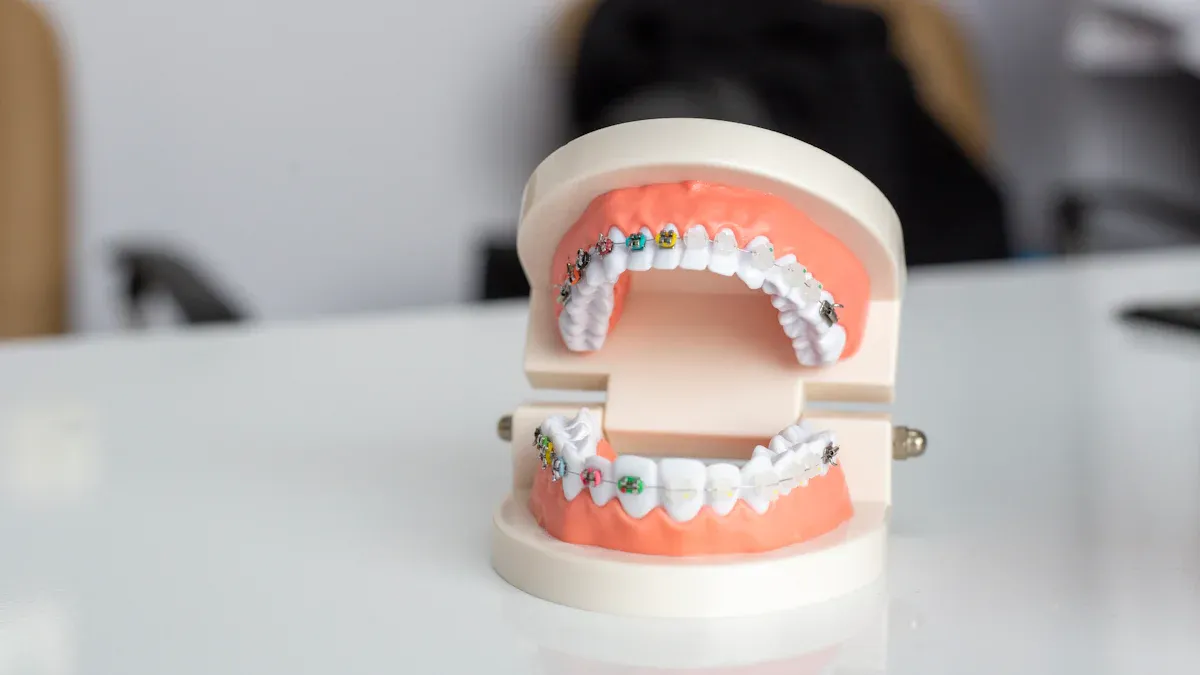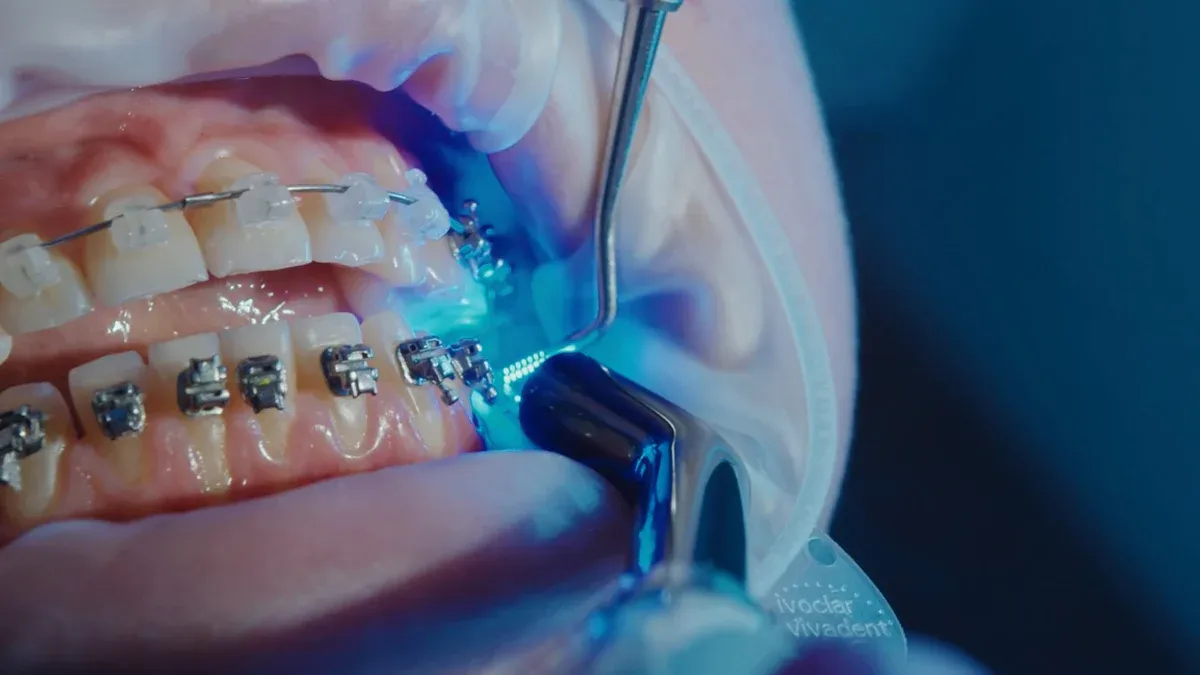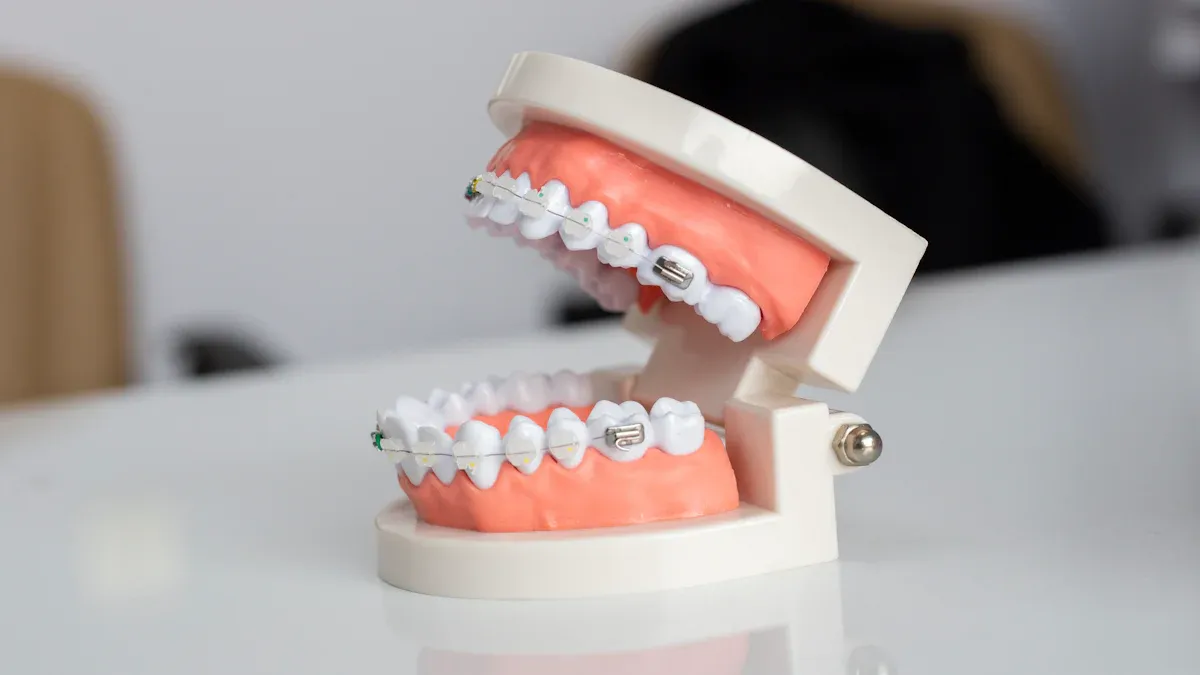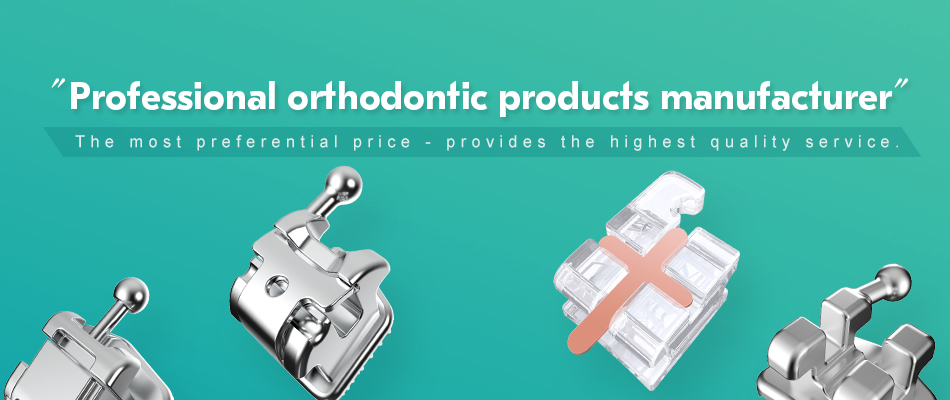
Return on investment (ROI) plays a vital role in the success of orthodontic clinics. Every decision, from treatment methods to material selection, impacts profitability and operational efficiency. A common dilemma faced by clinics is choosing between self-ligating brackets and traditional braces. While both options serve the same purpose, they differ significantly in cost, treatment efficiency, patient experience, and long-term outcomes. Clinics must also consider the value of ISO certified orthodontic materials, as these ensure quality and safety, which directly influence patient satisfaction and clinic reputation.
Key Takeaways
- Self-ligating brackets cut treatment time by almost half. Clinics can treat more patients faster.
- Patients feel more comfortable and need fewer visits with these brackets. This makes them happier and improves the clinic’s image.
- Using certified materials keeps treatments safe and high-quality. This builds trust and lowers risks for clinics.
- Self-ligating systems cost more at first but save money later. They need less fixing and fewer changes.
- Clinics using self-ligating brackets can earn more while giving better care.
Cost Analysis
Upfront Costs
The initial investment for orthodontic treatments varies depending on the type of braces used. Traditional braces typically cost between $3,000 and $7,000, while self-ligating braces range from $3,500 to $8,000. Although self-ligating brackets may have a slightly higher upfront cost, their advanced design often justifies the expense. Clinics that prioritize efficiency and patient satisfaction may find this initial investment worthwhile. Additionally, using ISO certified orthodontic materials ensures the quality and safety of these products, which can enhance patient trust and clinic reputation.
Maintenance Costs
Maintenance expenses play a significant role in determining the overall cost-effectiveness of orthodontic treatments. Traditional braces require frequent in-office adjustments, which can increase operational costs for clinics. In contrast, self-ligating braces eliminate the need for elastic bands and reduce the frequency of appointments. Patients with self-ligating brackets typically visit clinics less often, leading to potential savings on maintenance.
- Key differences in maintenance costs:
- Traditional braces demand regular adjustments, increasing clinic workload.
- Self-ligating braces reduce the need for archwire changes, minimizing appointment frequency.
- Fewer appointments translate to lower operational costs for clinics.
By choosing self-ligating brackets, clinics can optimize their resources and improve profitability over time.
Long-Term Financial Implications
The long-term financial benefits of self-ligating brackets often outweigh their higher upfront costs. These brackets reduce the need for frequent adjustments, saving time for both patients and practitioners. On average, clinics report two fewer appointments per patient when using self-ligating brackets compared to traditional braces. This reduction not only lowers treatment costs but also allows clinics to accommodate more patients, boosting revenue.
| Evidence | Details |
|---|---|
| Appointment Reduction | Self-ligating brackets reduce the need for archwire changes, leading to 2 fewer appointments on average. |
| Cost Implication | Fewer appointments translate to lower overall treatment costs for patients. |
Moreover, clinics that use ISO certified orthodontic materials benefit from enhanced durability and reliability, which reduces the likelihood of product failures. This ensures long-term patient satisfaction and strengthens the clinic’s reputation, contributing to a better return on investment.
Treatment Efficiency

Treatment Duration
Self-ligating brackets (SLBs) offer a significant advantage in reducing treatment duration compared to traditional braces. Their innovative design eliminates the need for elastomeric or steel ligature wires, utilizing hinge caps instead. This feature facilitates smoother and more efficient tooth movement, which can shorten the overall treatment time.
- Key benefits of self-ligating brackets:
- SLBs reduce frictional resistance, enabling faster alignment of teeth.
- The absence of ligatures minimizes complications, streamlining the treatment process.
Statistical studies highlight the efficiency of SLBs. On average, treatment time is 45% shorter with self-ligating systems compared to conventional brackets. This reduction not only benefits patients but also allows clinics to manage more cases within the same timeframe, enhancing operational efficiency.
Frequency of Adjustments
The frequency of adjustments required during orthodontic treatment directly impacts clinic resources and patient convenience. Traditional braces demand regular appointments for tightening and replacing elastic bands. In contrast, self-ligating brackets reduce the need for such frequent interventions.
A comparative analysis reveals that patients with SLBs require six fewer scheduled appointments on average. Additionally, emergency visits and issues like loose brackets occur less frequently with self-ligating systems. This reduction in appointments translates to lower operational costs for clinics and a more streamlined experience for patients.
| Measure | LightForce Brackets | Conventional Brackets |
|---|---|---|
| Average Scheduled Appointments | 6 fewer | More |
| Average Emergency Appointments | 1 fewer | More |
| Average Loose Brackets | 2 fewer | More |
Impact on Clinic Operations and Profitability
Self-ligating brackets significantly enhance clinic operations by reducing chair time and improving procedural efficiency. The simplified design of SLBs minimizes the time required for archwire ligation and removal. Clinics benefit from lower frictional resistance during procedures, which accelerates treatment steps and reduces patient chair time.
- Operational advantages of self-ligating systems:
- Faster archwire adjustments free up valuable clinic time.
- Improved infection control due to the absence of elastomeric ligatures.
These efficiencies enable clinics to accommodate more patients, increasing revenue potential. By optimizing resource allocation and reducing appointment frequency, self-ligating brackets contribute to a more profitable and efficient practice model.
Patient Satisfaction

Comfort and Convenience
Self-ligating brackets offer a superior level of comfort and convenience compared to traditional braces. Their advanced design applies gentle, consistent forces to teeth, which reduces soreness and discomfort during treatment. Patients often report a more pleasant experience due to the absence of elastic bands, which can cause irritation.
- Key advantages of self-ligating brackets:
- Faster treatment time due to reduced friction and resistance.
- Fewer office visits since they do not require frequent tightening.
- Improved oral hygiene as rubber ties, which trap food and plaque, are eliminated.
These features not only enhance patient satisfaction but also streamline the treatment process, making it more efficient for clinics.
Aesthetic Preferences
Aesthetics play a crucial role in patient satisfaction, especially for adults and teenagers who prioritize appearance during orthodontic treatment. Self-ligating brackets are available in clear or ceramic options, which blend seamlessly with natural teeth. This discreet appearance appeals to patients seeking a less noticeable solution.
Traditional braces, with their metal brackets and colorful elastics, may not align with the preferences of image-conscious individuals. By offering self-ligating systems, clinics can cater to a broader demographic, including professionals and young adults who value subtlety in their orthodontic care.
Influence on Clinic Reputation and Retention
Patient satisfaction directly impacts a clinic’s reputation and retention rates. Positive experiences with self-ligating brackets often lead to glowing reviews and word-of-mouth referrals. Patients appreciate the reduced treatment time, fewer appointments, and enhanced comfort, which contribute to a favorable perception of the clinic.
Satisfied patients are more likely to return for future treatments and recommend the clinic to friends and family. By prioritizing patient comfort and aesthetic preferences, clinics can build a loyal customer base and strengthen their market position.
Tip: Clinics that invest in advanced orthodontic solutions, such as self-ligating brackets, not only improve patient outcomes but also enhance their professional credibility.
Long-Term Benefits
Durability and Reliability
Self-ligating brackets demonstrate exceptional durability and reliability, making them a valuable choice for orthodontic clinics. Their advanced design eliminates the need for elastic bands, which often degrade over time. This feature reduces the likelihood of breakage or wear, ensuring consistent performance throughout the treatment period. Clinics benefit from fewer emergency visits related to damaged components, which optimizes operational efficiency.
Traditional braces, on the other hand, rely on elastomeric ties that can lose elasticity and accumulate debris. This not only impacts their functionality but also increases the risk of complications. By choosing self-ligating systems, clinics can provide patients with a more dependable treatment experience, enhancing satisfaction and trust.
Post-Treatment Care Requirements
Orthodontic treatments often require diligent post-treatment care to maintain results. Self-ligating brackets simplify this process by promoting better oral hygiene during treatment. Their design minimizes areas where food particles and plaque can accumulate, reducing the risk of cavities and gum issues. Patients find it easier to clean their teeth, which contributes to healthier outcomes after braces are removed.
In contrast, traditional braces create more challenges for oral hygiene due to their intricate structure. Patients may need additional cleaning tools and techniques to prevent dental problems. By offering self-ligating brackets, clinics can reduce the burden of post-treatment care for patients, leading to improved long-term oral health.
Success Rates and Patient Outcomes
Self-ligating brackets consistently deliver high success rates and positive patient outcomes. They apply gentle, consistent forces to teeth, reducing discomfort and soreness during treatment. Clinical studies reveal that patients using self-ligating systems report higher satisfaction levels and improved oral health-related quality of life. The MS3 self-ligating bracket, for example, has shown to enhance the treatment experience significantly, with fewer adjustments and higher acceptance scores.
Traditional braces, while effective, often result in more discomfort and frequent adjustments. Patients treated with self-ligating systems benefit from shorter treatment durations and fewer complications, which contribute to better overall outcomes. Clinics that adopt self-ligating brackets can achieve higher patient retention and a stronger reputation for delivering quality care.
Importance of ISO Certified Orthodontic Materials
Ensuring Quality and Safety
ISO certified orthodontic materials play a critical role in maintaining high standards of quality and safety in orthodontic practices. Certifications such as ISO 13485 demonstrate that manufacturers adhere to stringent industry standards. These certifications act as a mark of credibility, ensuring that the materials used in treatments are both safe and reliable.
Orthodontic suppliers certified under ISO 13485 implement robust quality management systems. This certification ensures compliance with regulatory requirements and guarantees consistent product quality. By proactively identifying and addressing potential issues, certified suppliers reduce the likelihood of defects, enhancing patient safety. Clinics that prioritize ISO certified orthodontic materials can confidently provide treatments that meet the highest safety standards.
Impact on Clinic Reputation
The use of ISO certified orthodontic materials significantly enhances a clinic’s reputation. Patients value clinics that prioritize safety and quality, and certifications serve as a visible assurance of these commitments. When clinics use certified materials, they demonstrate a dedication to excellence, which fosters trust among patients.
Positive patient experiences often translate into favorable reviews and referrals. Clinics that consistently deliver high-quality care build a strong reputation within their communities. This reputation not only attracts new patients but also encourages existing ones to return for future treatments. By incorporating ISO certified orthodontic materials into their practice, clinics can establish themselves as leaders in the field of orthodontics.
Contribution to Long-Term ROI
Investing in ISO certified orthodontic materials contributes to a clinic’s long-term return on investment. These materials offer enhanced durability and reliability, reducing the risk of product failures during treatment. Fewer complications mean fewer emergency visits, which optimizes clinic operations and minimizes additional costs.
Additionally, the trust and satisfaction generated by using certified materials lead to higher patient retention rates. Satisfied patients are more likely to recommend the clinic to others, increasing the patient base and revenue over time. By choosing ISO certified orthodontic materials, clinics not only ensure superior treatment outcomes but also secure sustainable financial growth.
Orthodontic clinics seeking to maximize ROI should carefully evaluate the comparative advantages of self-ligating brackets and traditional braces. Key findings highlight the following:
- Self-ligating brackets reduce treatment duration by 45% and require fewer adjustments, optimizing clinic operations.
- Patients report higher satisfaction due to enhanced comfort and aesthetics, improving clinic reputation and retention.
- ISO certified materials ensure safety, durability, and long-term reliability, reducing operational risks.
| Criteria | Details |
|---|---|
| Age Group | 14-25 years |
| Gender Distribution | 60% females, 40% males |
| Bracket Types | 55% conventional, 45% self-ligating |
| Treatment Frequency | Reviewed every 5 weeks |
Clinics should align their choice with patient demographics and operational goals. Self-ligating systems often provide a superior balance of efficiency, satisfaction, and profitability, making them a strategic investment for modern practices.
FAQ
What are the main differences between self-ligating brackets and traditional braces?
Self-ligating brackets use a sliding mechanism to hold wires, eliminating the need for elastic bands. This design reduces friction and shortens treatment time. Traditional braces rely on elastics, which require frequent adjustments and may cause more discomfort.
How do self-ligating brackets improve clinic efficiency?
Self-ligating brackets reduce the frequency of adjustments and chair time per patient. Clinics can accommodate more patients and streamline operations, leading to increased profitability and better resource management.
Are self-ligating brackets suitable for all patients?
Yes, self-ligating brackets work for most orthodontic cases. However, the choice depends on individual treatment needs and patient preferences. Clinics should evaluate each case to determine the best option.
Do self-ligating brackets cost more than traditional braces?
Self-ligating brackets often have higher upfront costs. However, they reduce maintenance expenses and treatment duration, offering better long-term value for clinics and patients.
Why is it important to use ISO certified orthodontic materials?
ISO certified materials ensure safety, durability, and consistent quality. Clinics using these materials build trust with patients, enhance their reputation, and reduce risks associated with product failures, contributing to long-term ROI.
Post time: Apr-08-2025


